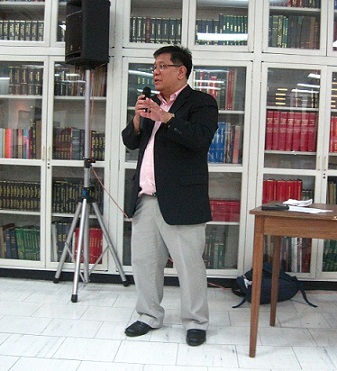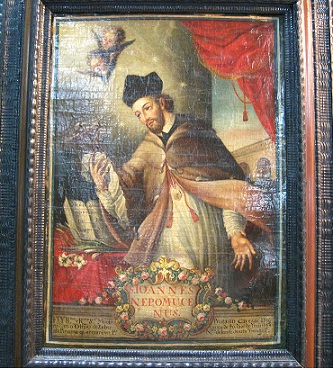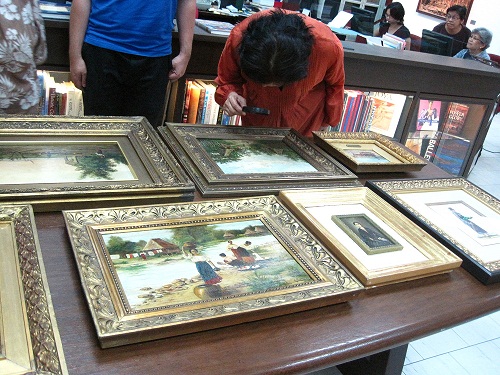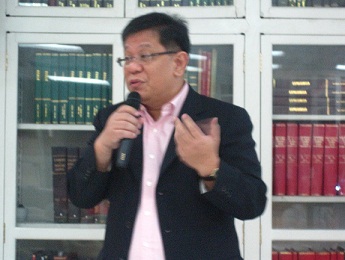Text and photos by ELIZABETH LOLARGA
 FOR a head of an office that encourages overseas Filipino workers to come home and be part of a dynamic sector called “the creative industries,” Ambassador Jose Maria A. Cariño has to work with a budget of one million pesos, not a centavo more. He said the amount is just enough for Mommy Dionesia to buy a luxury-brand handbag (she is Manny Pacquiao’s mother).
FOR a head of an office that encourages overseas Filipino workers to come home and be part of a dynamic sector called “the creative industries,” Ambassador Jose Maria A. Cariño has to work with a budget of one million pesos, not a centavo more. He said the amount is just enough for Mommy Dionesia to buy a luxury-brand handbag (she is Manny Pacquiao’s mother).
The chair alternate of the Technical Cooperation Council of the Philippines and head of the cultural diplomacy unit of the Office of the Undersecretary for International Economic Relations and Cultural Affairs, Cariño is also the author of books on colonial art (Discovering Philippine Art in Spain and Jose Honorato Lozano, Filipinas 1847) and a lively raconteur on art and artists.
At his recent lecture at the Lopez Museum and Library as part of its “Understanding Philippine Visual Art,” he said his offices are tasked with encouraging the creation of jobs in the traditional and contemporary arts. He cited Filipino tele-novelas as good exports to different parts of the world to the extent that the prime minister of an African country stops work at a certain time of the day because “It’s my Filipino teleserye hour.”
What he wants to happen is for the television networks that produce teleseryes to include more facets of Philippine culture. South Korea has successfully done this in the TV series that it exports to other countries (e.g., focus on Korean food when characters are dining).
Cariño said, “Philippine food is considered the ugly sister of Thai food. Our food is generally brown–from very brown to light brown to totally black like dinuguan. Or it can be red like kare-kare.” The Departments of Foreign Affairs and Trade and Industry bring Filipino chefs abroad on their road trips to add a cultural component in these shows that reach businessmen and students.
 He said his office recognizes “the importance of transcendence and recognizing the culture of the past.” He added, “We’re not for art for art’s sake. We don’t want people to be cutting their ears off or shooting their heads off so we want to teach artists the economic component. Even the Berklee College of Music (in Boston, Massachusetts) now offers a subject called Business Music to teach musicians how to manage their funds.”
He said his office recognizes “the importance of transcendence and recognizing the culture of the past.” He added, “We’re not for art for art’s sake. We don’t want people to be cutting their ears off or shooting their heads off so we want to teach artists the economic component. Even the Berklee College of Music (in Boston, Massachusetts) now offers a subject called Business Music to teach musicians how to manage their funds.”
In his work with the Philippine International Cooperation Agency, he has seen the Philippines move its status from a donee (recipient of donations) to a donor country. He said, “We’re no longer an ordinary, backwater country but a new, middle-income one.”
In countries where the tribal culture is strong and where women are smacked as a sign of affection, the Philippines brings gender and development experts to Bhutan, Myanmar, East Timor, Cambodia, among others, to teach equality between men and women. These people are also taught how to make tinapa or tuyo and go into micro-enterprises.
Cariño said these are being done with an awareness of the lessons learned when droves of Thai observers were allowed into the Philippines and “copied from us and became more successful. We are learning how to market, package and inject our culture because it is what makes us unique from everyone else.”
He mentioned that the many works of Juan Luna, Antonio Malantic, Lozana and other painters from the 19th century could be found in Europe’s flea markets at a time when the inheritors of castles and palaces found the upkeep of their properties too exorbitant. What these descendants of the nobility do is to empty those huge mansions of their contents, sell these and partition the huge mansions into condominium units.
 Cariño said this partly explained why “the best Philippine paintings are not in our museums but in private collections” because the collectors could afford to shop abroad. He also said historians tend make history glorious by sweetening it, but painters of the past are literally able to paint who we were as a people, what we wore, our costumes rich in color, what we ate, how we worked, how we liked to sing while we worked, our flora and fauna.
Cariño said this partly explained why “the best Philippine paintings are not in our museums but in private collections” because the collectors could afford to shop abroad. He also said historians tend make history glorious by sweetening it, but painters of the past are literally able to paint who we were as a people, what we wore, our costumes rich in color, what we ate, how we worked, how we liked to sing while we worked, our flora and fauna.
During his lecture he also pointed out how the Bureau of Internal Revenue was committing a big mistake by heavily taxing Filipino works of art, particularly antiquities, that collectors are bringing in.
He said these taxes should be levied on the Filipino works that are being brought out. “If you are bringing in a painting that is part of our cultural heritage, as BIR, you shouldn’t touch it. It’s bad enough that little or nothing is being spent on culture and heritage here but to tax the collectors who’re bringing in important works so we can see them again…” He left his sentence unfinished.
